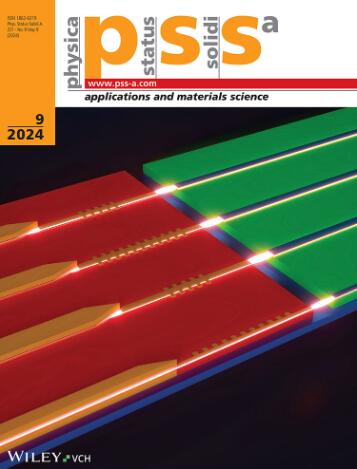通过氨辅助面间退火消除厚 InGaN 层中的 V 形坑
IF 1.9
4区 材料科学
Q3 MATERIALS SCIENCE, MULTIDISCIPLINARY
Physica Status Solidi A-applications and Materials Science
Pub Date : 2024-08-23
DOI:10.1002/pssa.202400052
引用次数: 0
摘要
氮化镓(InGaN)是第三族氮化物半导体,由于其优异的物理性能,有望在光电子领域得到广泛应用。然而,InGaN 存在各种局限性。本研究利用气相和面内质量传输进行面对面退火 (FFA),以改善 InGaN 模板的表面平整度。InGaN 层生长在 GaN 模板上,而 GaN 模板是利用金属有机物气相外延法生长在 c 平面蓝宝石衬底上的。在 1050 °C 下进行 20 分钟的 NH3 辅助 FFA,使 InGaN 模板上的 V 形坑消失,尽管它们的初始密度为 3.3 × 108 cm-2。下层 InGaN 的表面状况比上层 InGaN 差,这是由于 FFA 诱导了质量从下层向上迁移,从而消除了 V 形坑。通过欧杰电子能谱和能量色散 X 射线能谱对上层进行成分分析,发现尽管进行了高温退火,但仍存在 In 峰,从而证实了 InGaN 的存在。这项研究结果为未来的 InGaN 晶体生长和基于 InGaN 的器件制造提供了可能性。本文章由计算机程序翻译,如有差异,请以英文原文为准。
Elimination of V‐Shaped Pits in Thick InGaN Layers via Ammonia‐Assisted Face‐to‐Face Annealing
InGaN, a group‐III nitride semiconductor, is expected to be widely used in the field of optoelectronics, owing to its excellent physical properties. However, InGaN has various limitations. This study reports face‐to‐face annealing (FFA) using vapor‐phase and in‐plane mass transport to improve the surface flatness of an InGaN template. InGaN layers are grown on a GaN template that is grown on a c ‐plane sapphire substrate using metal–organic vapor‐phase epitaxy. NH3 ‐assisted FFA is performed at 1050 °C for 20 min, causing V‐pits to vanish from the InGaN template despite their initial density of 3.3 × 108 cm−2 . The surface condition of the lower InGaN layer is worse than that of the upper InGaN layer due to the FFA‐induced upward mass transport from the lower layer, thereby eliminating the V‐pits. Compositional analysis of the upper layer through Auger electron spectroscopy and energy‐dispersive X‐ray spectroscopy reveals In peaks despite high‐temperature annealing, thus confirming the presence of InGaN. The results of this study offer possibilities for future InGaN crystal growth and InGaN‐based device fabrication.
求助全文
通过发布文献求助,成功后即可免费获取论文全文。
去求助
来源期刊
CiteScore
3.70
自引率
5.00%
发文量
393
审稿时长
2 months
期刊介绍:
The physica status solidi (pss) journal group is devoted to the thorough peer review and the rapid publication of new and important results in all fields of solid state and materials physics, from basic science to applications and devices. Among the largest and most established international publications, the pss journals publish reviews, letters and original articles, as regular content as well as in special issues and topical sections.

 求助内容:
求助内容: 应助结果提醒方式:
应助结果提醒方式:


